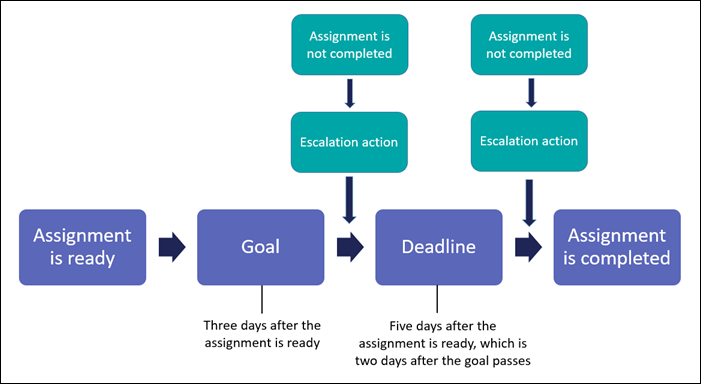Completing work on time
Enforce the service-level agreements (SLAs) that you make with customers and stakeholders by creating goals and deadlines for case workers. By implementing SLAs, you make a commitment to your customers and agree on a timeline for delivery of your projects.
A service-level agreement (SLA) defines a goal and deadline, which are intervals of time that you can apply to a case or elements in the life cycle of a case. By using SLAs, you can standardize the way that case workers resolve cases in your application.
For relevant training materials, see the Completing work on time and Extending service-level agreement configurations modules on Pega Academy.
When you define a goal for an assignment, you define the suggested time required to resolve work. When you define a deadline, you define the ultimate time in which to resolve work. You can also define escalation actions that your application performs when the goal and deadline expire. In a sample scenario, the goal for an assignment is three days and the deadline is five days. An application starts calculating the goal and deadline after the assignment is ready for processing. If a case worker misses to complete the assignment within three days, an escalation action occurs and the worker receives a notification about an elapsed goal. If the case worker fails to complete work within the next two days, another escalation action takes place and the manager of the case worker receives a notification about a passed deadline. Finally, the worker completes the assignment. The following figure shows the process:

You can apply SLAs to the following elements of case processing:
- Case
- Starts when a user starts or reopens a case, and stops when the case reaches resolution.
- Stage
- Starts when a case enters the stage, and ends when the case leaves the stage. You can apply SLAs to primary and alternate stages, and to optional stages.
- Process in a stage
- Starts when a process starts, and ends when the last step in the process finishes. You can apply SLAs to processes that are part of a case life cycle and to optional processes.
- Assignment
Starts when a user or an automation creates or routes an assignment to a work queue or worklist so that the assignment is ready for processing, and ends when the assignment is completed or stops due to an error condition.
The time at which a user opens the form for an assignment has no effect on the service-level agreement.
- Approval step
- Starts after a user receives the approval step that is ready for processing, and ends when the step is completed.
To help workers prioritize work, each assignment includes urgency, which is a numeric value that indicates how important the assignment is. You can decide how the urgency increases after a goal or deadline elapses to bring attention of workers to the tasks that are top priority and need immediate processing.
- Urgency
Urgency is a numeric value, ranging from 0 to 100, that worklists and cases display to indicate the importance of every assignment. Use urgency to bring visibility to unresolved assignments and cases in your application that need immediate action from case workers. As a result, you ensure that cases reach resolution within the timelines that you define with your stakeholders.
- Setting service-level agreements (SLAs) for case resolution
Encourage customer service representatives (CSRs) to resolve cases on time and enforce your service-level agreements (SLAs) by setting goals and deadlines for a case type. As a result, you save time and resources because you avoid missing deadlines. SLA measurement starts when the case starts and ends when the case finishes.
- Setting service-level agreements (SLAs) for stages, processes, and steps
Ensure that users complete assignments on time by assigning service-level agreements (SLAs) to stages, processes, and steps. By implementing SLAs, you enforce timely case resolution and ensure that users follow the timeline that you agree on with your customers.
- Adjusting initial urgency for an assignment
Communicate the priority of a given task by adjusting initial urgency. By configuring an assignment urgency, you provide a common understanding of task importance. As a result, you optimize workload management so that users can make informed decisions about which task to process next.
- Creating a service-level agreement (SLA) rule
Enforce service-level agreements (SLAs) and maintain timely resolution of cases by defining the goal, deadline, and passed deadline time intervals. By creating an SLA rule, you can quickly reuse the SLA settings for multiple assignments.
- Configuring delayed service-level processing
Provide solutions in scenarios when users need to wait before processing an assignment by delaying service-level agreements (SLAs). As a result, you deliver a flexible application and adjust processing to the unique business requirements of your customers.
- Defining an escalation action for a case
Ensure that your business process reaches a resolution on time, by defining an escalation action for a case. By enforcing service-level agreements and implementing escalation actions, you enforce timely resolution of cases and meet deadlines that you agree on with your customers.
- Defining an escalation action for a stage and a process
Ensure that your business use case moves forward in a timely manner by defining an escalation action for a stage and a process in your case life cycle. By notifying interested parties about an elapsed goal or deadline, you can keep the time frames that you agree on for your business use cases.
- Defining an escalation action for an incomplete assignment
Reduce the risk of unfinished work in a case by defining an escalation action, such as a notification to the manager. The manager receives the notification when an assignment exceeds its goal or deadline.
Previous topic Changing a stage with open assignments Next topic Urgency
